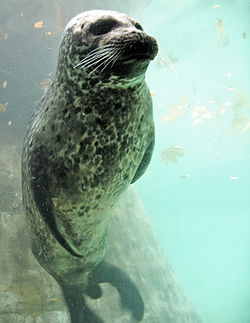 |
| Harbor seal (Phoca vitulina), courtesy L. Heafner. |
Mammals with whiskers are not exclusively terrestrial. Pinnipeds possess whiskers on their snout. Szymonowicz (1930) was the first to describe the follicular innervation of facial whisker follicles in the harbor seal Phoca vitulina. Recent behavioral studies provide astounding evidence that harbor seals can locate objects by their wake with their whiskers (Dehnhardt and others, 2001).
Not only carnivorous marine mammals seem to make good use of their whiskers that way. Notably, the herbivorous Florida manatee Trichechus manatus latirostris, a subspecies of the West Indian manatee, also appears to use whiskers for underwater exploration and navigation. Moreover, the long whiskers surrounding the mouth are employed for palpating and grasping plant matter when feeding. Florida manatees inhabit shallow, warm coastal waters. When the cold of winter arrives, the animals migrate south and up rivers into ponds and warm springs, where they congregate to forage and socialize.
Much we know about the Florida manatee brain, we owe to the ground-laying research of Professor Roger Reep from the University of Florida at Gainesville and his colleagues. Erica Goode described his work in her article with the title "Sleek? Well, No. Complex? Yes, Indeed." published online in The New York Times on Aug. 29, 2006. The article contains a slide show with Professor Reep's comments entitled "The Mind of The Manatee" which includes detailed photographs of the whiskers. Professor Reep co-authored an exhaustive book on manatees with the title "The Florida Manatee: Biology and Conservation
The whiskers of the Florida manatee are densest on the face (2,000) with greatest density, roughly 600, in an area between the upper lip and the nose known as the oral disk (Reep and others, 2001). Another 3,000 cover the remaining body (Reep and others, 2002). Sarko and others (2007) recently described the follicles of the manatee facial whiskers in anatomical detail. Although the facial whisker follicles receive at on average 50 myelinated nerve fibers per follicle almost twice the follicular innervation the whiskers of the rest of the body receive at 30, the heightened sense of touch comprising the entire body surface may represent a great advantage for navigating the dimly lit, muddy waters of the manatee's grazing grounds.
Considering their body size, manatees possess small brains (Reep and O'Shea, 1990). Unlike our heavily convoluted cerebral cortex, the manatee's is smooth showing only one fissure, homologous to our Rolandic fissure, running from top to bottom at the center of the cerebral hemisphere (shown in this NYT graphic with the title "A Sensitive creature"). Compared to ours, the manatee cortex seems thicker, and the gray matter differentiated in more layers. In addition, Professor Reep notes in Erica Goode's article condensations of nerve cells in the deep layers of somatic sensory cortex that may represent the whiskers topographically analogous to the barrels in mouse somatic sensory cortex (Woolsey and Van der Loos, 1970). Interestingly, Professor Reep also found such cell condensations in auditory cortex. The meaning of this finding is not yet understood.
Professor Reep further reports that manatees aptly localize sources of brief tone pips as low as 23 Hz in pitch. The cell condensations in auditory cortex may therefore suggest crossmodal processing of low frequency vibrations sensed with the whiskers. I discussed that rodent whiskers may detect low frequency ground motion in my post with the title "The Quest for the Infrasound Acoustic Fovea" published Oct 12, 2009. Without doubt, uncovering the nerve cell mechanisms underlying manatee behavior will provide exciting novel insights into the detection of low-frequency water motion by whiskered marine mammals and the processing of tactile input for underwater navigation.

If we peer through the above window preferably in the mornings EST, we may once in a while see manatees grazing and socializing in their habitat at Ellie Schiller Homosassa Springs Wildlife State Park, Florida, via their manatee cam (with permission, Susan Strawbridge, Ellie Schiller Homosassa Springs Wildlife State Park).
For close fullscreen examination of manatee whisker action, we must visit the park's manatee cam, which also provides a series of the ten most recent images for an improved sense of the action and detailed information on visitor activities at the park. An actual visit would be most exciting of course.
References
- Dehnhardt G, Mauck B, Hanke W, Bleckmann H (2001) Hydrodynamic trail-following in harbor seals (Phoca vitulina). Science 293:102-104.
- Reep RL, Bonde RK (2010)
The Florida Manatee: Biology and Conservation. University Press of Florida, Gainesville.
- Reep RL, O'Shea TJ (1990) Regional brain morphometry and lissencephaly in the Sirenia. Brain Behav Evol 35:185-194.
- Reep RL, Marshall CD, Stoll ML (2002) Tactile hairs on the postcranial body in Florida manatees: a Mammalian lateral line? Brain Behav Evol 59:141-154.
- Reep RL, Stoll ML, Marshall CD, Homer BL, Samuelson DA (2001) Microanatomy of facial vibrissae in the Florida manatee: the basis for specialized sensory function and oripulation.Brain Behav Evol 58:1-14.
- Sarko DK, Reep RL, Mazurkiewicz JE, Rice FL (2007) Adaptations in the structure and innervation of follicle-sinus complexes to an aquatic environment as seen in the Florida manatee (Trichechus manatus latirostris). J Comp Neurol 504:217-237.
- Szymonowicz WL (1930) Die Innervation der Sinushaare des Seehundes (Phoca vitulina). Bull Internat Acad Polonaise Sci et Lettr C1 Sci Math et Nat Se Cracovie: 371-390.
- Vincent SB (1913) The tactile hair of the white rat. J Comp Neurol 23:1-34.
- Woolsey TA, Van der Loos H (1970) The structural organization of layer IV in the somatosensory region (SI) of mouse cerebral cortex. The description of a cortical field composed of discrete cytoarchitectonic units. Brain Res 17:205-242.








No comments:
Post a Comment